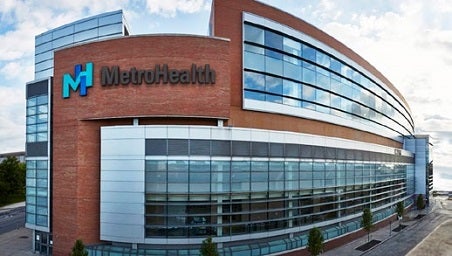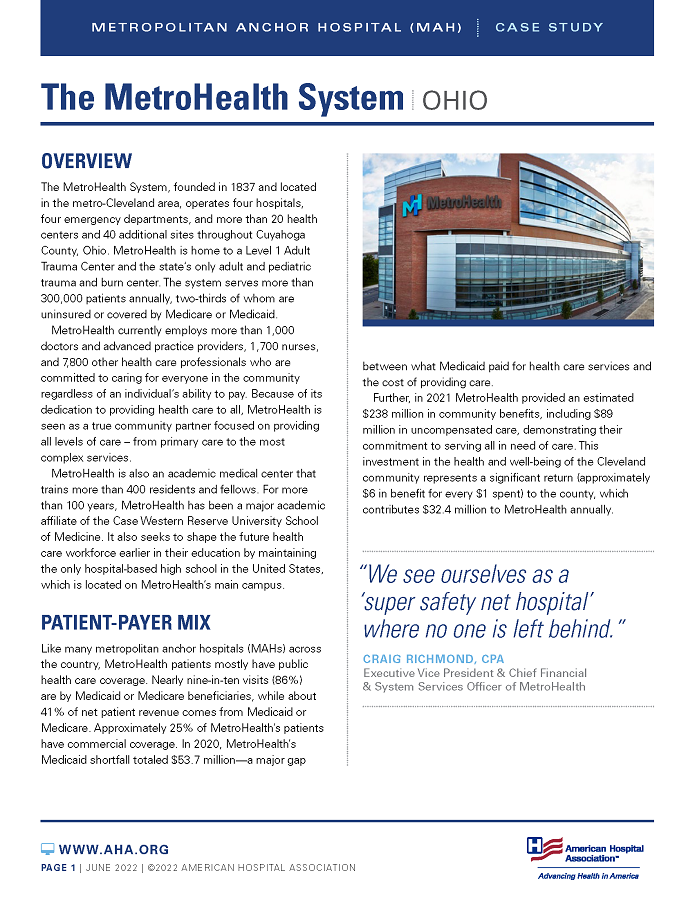

The MetroHealth System | Ohio
Metropolitan Anchor Hospital (MAH) | Case Study
Overview
 The MetroHealth System, founded in 1837 and located in the metro-Cleveland area, operates four hospitals, four emergency departments, and more than 20 health centers and 40 additional sites throughout Cuyahoga County, Ohio. MetroHealth is home to a Level 1 Adult Trauma Center and the state’s only adult and pediatric trauma and burn center. The system serves more than 300,000 patients annually, two-thirds of whom are uninsured or covered by Medicare or Medicaid.
The MetroHealth System, founded in 1837 and located in the metro-Cleveland area, operates four hospitals, four emergency departments, and more than 20 health centers and 40 additional sites throughout Cuyahoga County, Ohio. MetroHealth is home to a Level 1 Adult Trauma Center and the state’s only adult and pediatric trauma and burn center. The system serves more than 300,000 patients annually, two-thirds of whom are uninsured or covered by Medicare or Medicaid.
MetroHealth currently employs more than 1,000 doctors and advanced practice providers, 1,700 nurses, and 7,800 other health care professionals who are committed to caring for everyone in the community regardless of an individual’s ability to pay. Because of its dedication to providing health care to all, MetroHealth is seen as a true community partner focused on providing all levels of care – from primary care to the most complex services.
MetroHealth is also an academic medical center that trains more than 400 residents and fellows. For more than 100 years, MetroHealth has been a major academic affiliate of the Case Western Reserve University School of Medicine. It also seeks to shape the future health care workforce earlier in their education by maintaining the only hospital-based high school in the United States, which is located on MetroHealth’s main campus.
Patient–Payer Mix
Like many metropolitan anchor hospitals (MAHs) across the country, MetroHealth patients mostly have public health care coverage. Nearly nine-in-ten visits (86%) are by Medicaid or Medicare beneficiaries, while about 41% of net patient revenue comes from Medicaid or Medicare. Approximately 25% of MetroHealth’s patients have commercial coverage. In 2020, MetroHealth’s Medicaid shortfall totaled $53.7 million—a major gap between what Medicaid paid for health care services and the cost of providing care.
Further, in 2021 MetroHealth provided an estimated $238 million in community benefits, including $89 million in uncompensated care, demonstrating their commitment to serving all in need of care. This investment in the health and well-being of the Cleveland community represents a significant return (approximately $6 in benefit for every $1 spent) to the county, which contributes $32.4 million to MetroHealth annually.
“We see ourselves as a ‘super safety net hospital’ where no one is left behind.”
Craig Richmond, CPA
Executive Vice President & Chief Financial & System Services Officer of MetroHealth
Commitment to the Community
As a valued MAH, MetroHealth plays an essential role in the region. While Greater Cleveland is home to some of the best health care institutions in the world, historically, many area residents have experienced poor health outcomes. MetroHealth takes a comprehensive approach to improving poor health outcomes. MetroHealth provides quality clinical care and beyond, by addressing the societal factors that influence a person’s health status. To improve community health and wellbeing—especially among structurally marginalized populations—MetroHealth supports a variety of programs including affordable housing, convenient transportation, community partnerships, education, and much more.
Addressing Social Determinants of Health
Defined as a catalyst of change for health, neighborhoods, the economy, and the future, MetroHealth launched its Institute for H.O.P.E.™ (Health, Opportunity, Partnership, Empowerment) in 2019 to implement a coordinated, collaborative and strategic approach to support patients with non-medical needs such as healthful food, stable housing, transportation, and job training. Located on MetroHealth’s main campus, the Institute supports an economic opportunity center where community residents can build workforce skills like computer literacy, résumé writing, and interviewing. The Institute also includes a grocery store, a food pantry, and a community kitchen to give local residents access to healthful and nutritious food. MetroHealth has begun executing on a $100 million investment in affordable housing, with the opening of a 72-unit affordable housing location in late Summer 2022 and a 200-unit affordable senior housing location slated to open in 2024.
Training the Future Healthcare Workforce
MetroHealth is home to Lincoln-West School of Science and Health, the only hospital-based high school campus in the United States. Combining a traditional curriculum with interactive learning in a health care setting, the school engages more than 170 students in grades 9-12 with plans to expand to accommodate more students in the future. Black and Hispanic students constitute 80% of the student body at Lincoln-West.
“Our Institute of H.O.P.E. is a model that can be replicated across the country as a whole because of its significant impact and improved outcomes in just two years.”
Craig Richmond, CPA
MetroHealth
Metropolitan Anchor Hospitals Need Support
Annual reimbursement cuts have put a real strain on a system that primarily serves Medicare, Medicaid, and uninsured patients. These cuts put the community programs that MetroHealth has established – and that have shown to improve the health and well-being of the Cleveland community – at risk. Despite MetroHealth’s desire to build upon the success of its community programs, additional resources are needed to support continued investment in these initiatives.
Adequate, sustained federal support must be put in place so that MAHs can plan for the future, build upon the success of vital community programs, and continue to focus on realizing healthy, inclusive, and thriving communities.


